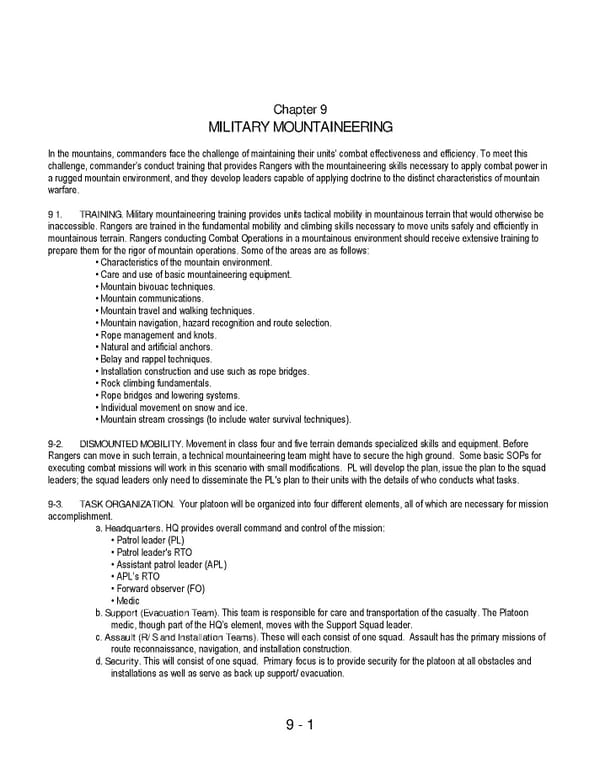9 - 1 Chapter 9 MILITARY MOUNTAINEERING In the mountains, commanders face the challenge of maintaining their units’ combat effectiveness and efficiency. To meet this challenge, commander’s conduct training that provides Rangers with the mountaineering skills necessary to apply combat power in a rugged mountain environment, and they develop leaders capable of applying doctrine to the distinct characteristics of mountain warfare. 9 1. TRAINING. Military mountaineering training provides units tactical mobility in mountainous terrain that would otherwise be inaccessible. Rangers are trained in the fundamental mobility and climbing skills necessary to move units safely and efficiently in mountainous terrain. Rangers conducting Combat Operations in a mountainous environment should receive extensive training to prepare them for the rigor of mountain operations. Some of the areas are as follows: • Characteristics of the mountain environment. • Care and use of basic mountaineering equipment. • Mountain bivouac techniques. • Mountain communications. • Mountain travel and walking techniques. • Mountain navigation, hazard recognition and route selection. • Rope management and knots. • Natural and artificial anchors. • Belay and rappel techniques. • Installation construction and use such as rope bridges. • Rock climbing fundamentals. • Rope bridges and lowering systems. • Individual movement on snow and ice. • Mountain stream crossings (to include water survival techniques). 9-2. DISMOUNTED MOBILITY. Movement in class four and five terrain demands specialized skills and equipment. Before Rangers can move in such terrain, a technical mountaineering team might have to secure the high ground. Some basic SOPs for executing combat missions will work in this scenario with small modifications. PL will develop the plan, issue the plan to the squad leaders; the squad leaders only need to disseminate the PL's plan to their units with the details of who conducts what tasks. 9-3. TASK ORGANIZATION. Your platoon will be organized into four different elements, all of which are necessary for mission accomplishment. a. Headquarters. HQ provides overall command and control of the mission: • Patrol leader (PL) • Patrol leader's RTO • Assistant patrol leader (APL) • APL’s RTO • Forward observer (FO) • Medic b. Support (Evacuation Team). This team is responsible for care and transportation of the casualty. The Platoon medic, though part of the HQ’s element, moves with the Support Squad leader. c. Assault (R/ S and Installation Teams). These will each consist of one squad. Assault has the primary missions of route reconnaissance, navigation, and installation construction. d. Security. This will consist of one squad. Primary focus is to provide security for the platoon at all obstacles and installations as well as serve as back up support/ evacuation.
 Ranger Handbook Page 168 Page 170
Ranger Handbook Page 168 Page 170